This article relies largely or entirely on a single source .(August 2022) |
Sri ChautariaBam Shah or Brahma Shah was an administrator of Nepal. He belongs to Shah Dynasty of Gorkha. He was Governor of Kumaun Province during Anglo-Nepalese war.
This article relies largely or entirely on a single source .(August 2022) |
Sri ChautariaBam Shah or Brahma Shah was an administrator of Nepal. He belongs to Shah Dynasty of Gorkha. He was Governor of Kumaun Province during Anglo-Nepalese war.
He was born to Birbaha Shah. He was grandson of Maharaj Adhirajkumar Chandrarup Shah, 4th son of King Prithvipati Shah of Gorkha. His 3 brothers were Dilip Shah, Hasti Dal Shah (killed in the Anglo-Nepalese war) and Rudra Bir Shah.[ citation needed ]
He was a Minister of State in 1800 A.D. and the Governor of Kumaun from 1814 to 1815 A.D. at Anglo-Nepalese war. Out at west Nepalese were hopelessly overextended. Kumaun, a key link in Nepal Army communications with Far West was defended by around 750 Nepalese with equal number of Kumauni irregulars, altogether 1500 men to defend a whole province. Doti which was east of Kumaun had been practically stripped out of troops. Governor Bam Shah had full responsibility of defense of the province. British force numbering initially over 4500 men was easily able to out maneuver Nepalese Army defenders and had to abandon one post after another. Despite significant victory over Captain Hearsey's force which had been sent in flanking movement through Eastern Kumaun and the capture of captain himself, Bam Shah's Nepalese force couldn't stern the tide of British advance. Meanwhile, Lord Hastings sent Colonel Nicolls, Quartermaster-General for all British force in India, to take charge of Almoda campaign and assigned 2000 army men with large irregulars against 1000 Nepalese. Bam Shah's brother Hasti Dal Shah arrived with 500 men were intercepted at Almoda's Northern Line of Communications with Kathmandu. Hastidal was killed at the first moments and Nepalese suffered heavy losses. The news reached Almoda Fort which was under responsibility of Bam Shah. British was able to establish gun positions at seventy yards from gate of fort of Almoda and the British artillery demolished walls of fort at point blank range. Bam Shah surrendered Almoda on 27 April 1815 A.D. He then sent letter to Bada Kaji Amar Singh Thapa who was Supreme Commander of Western Front, about the fall of Almora. [1]
He had four sons Sri Chautaria Daksha Shah, Mohan Bir Shah, Nir Bhanjan Shah and Bhakta Keshar Shah. Actress Sharmila Malla is the descendant of Chautaria Bam Shah.[ citation needed ]
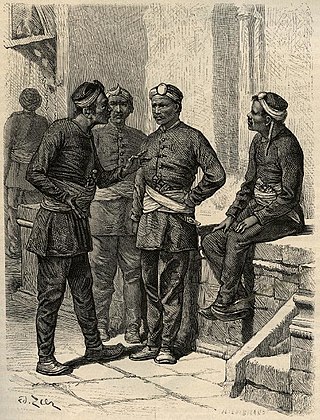
The Gurkhas or Gorkhas, with the endonym Gorkhali, are soldiers native to the Indian subcontinent, chiefly residing within Nepal and some parts of North India.

The Anglo-Nepalese War, also known as the Gorkha War, was fought between the Gorkhali army of the Kingdom of Nepal and the forces of the British East India Company (EIC). Both sides had ambitious expansion plans for the mountainous north of the Indian subcontinent. The war ended with a British victory and the signing of the Treaty of Sugauli in 1816, which ceded some of the Nepalese-controlled territory to the EIC. The British war effort was led by the EIC against the Kingdom of Gorkha. Most of the Kingdom of Gorkha's war effort was led by the two Thapa families: the Thapa dynasty and the family of Amar Singh Thapa.

Bhimsen Thapa was a Nepalese statesman who served as the Mukhtiyar and de facto ruler of Nepal from 1806 to 1837. He is widely known as the longest-serving prime minister of Nepal and was inducted into the "National heroes of Nepal" by King Mahendra Bir Bikram Shah.
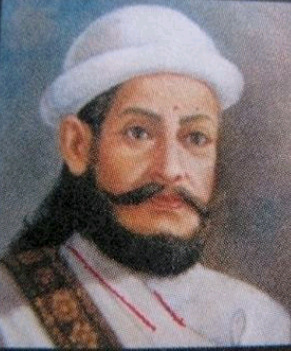
Amar Singh Thapa distinguished as Badakaji Amar Singh Thapa(Nepali: बडाकाजी अमर सिंह थापा), or Amar Singh Thapa The Elder, also known by the honorific name Bada Kaji or Budha Kaji, was a Gorkhali military general, governor and warlord in the Kingdom of Nepal. He was the overall commander of the Nepal Army in the conquest of Western Provinces and authoritative ruler of Kumaon, Garhwal in the Kingdom of Nepal. He was referred by the King of Nepal to have been deployed as Mukhtiyar of Western Provinces of Kumaon, Garhwal. He is often hailed as Living Tiger of Nepal and was posthumously regarded as one of the national heroes of Nepal, who led the Anglo-Nepalese War for the Gorkhali Army. Amarsingh Chowk Pokhara and Shree Amarsingh Model Higher Secondary School are named after Amar Singh Thapa.
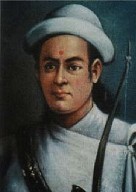
Balbhadra Kunwar Chhetri was a Gorkhali military General, Commander and administrator in the Sikh Empire and the Kingdom of Nepal. He is one of the National heroes of Nepal. He was highly praised for his military skill for the defence of Nalapani fort in the Anglo-Nepalese War (1814–1816). He was a captain in the Nepalese military and was tasked as commander to protect the forts of Dehradun.
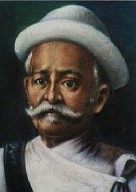
Bhakti Thapa Chhetri was a Nepali military commander and administrator in the Kingdom of Nepal. Initially, he served the Kingdom of Lamjung. He is considered one of the national heroes of Nepal.

The Shah dynasty, also known as the Shahs of Gorkha or the Royal House of Gorkha, was the ruling Chaubise Thakuri dynasty and the founder of the Gorkha Kingdom from 1559 to 1768 and later the unified Kingdom of Nepal from 1768 to 28 May 2008.

The unification of Nepal was the process of building the modern Nepalese state, from fractured petty kingdoms including the Baise Rajya and the Chaubisi Rajya, which began in 1743 AD. The prominent figure in the unification campaign was Prithvi Narayan Shah, King of Gorkha. On 25 September 1768, he officially announced the creation of the Kingdom of Nepal and moved his capital from Gorkha to the city of Kathmandu.
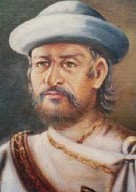
Basnyat/Basnet family or Basnyat/Basnet dynasty was a Khas-Chhetri and a warlord clan family involved in the politics and administration of the Gorkha Kingdom and Kingdom of Nepal. This family got entry into Thar Ghar aristocracy group of Gorkha at the time of King Prithvi Narayan Shah. It was one of the four noble families to be involved in active politics of Nepal together with the Shah dynasty, Pande family and the Thapa dynasty before the rise of the Rana dynasty. This family is descended from Shivaram Singh Basnyat, the commander of Gorkhali forces and a member of Shreepali Basnyat clan of Gorkha. This family was maritally linked to Kala (Black) Pande section of the Pande dynasty through Chitravati Pande who married Kaji Kehar Singh Basnyat. This family was the last Kshatriya (Chhetri) political family to be wiped out from the central power by Jung Bahadur Rana of Kunwar family during the Bhandarkhal Massacre in 1846 for the conspiracy to take the power leading to people suffering from 104 long years of the Rana rule.

Damodar Pande was the Mulkaji of Nepal from 1803 until March 1804 and the most influential Kaji from 1794 to his execution on March 13, 1804. He is also arguably referred to as the first Prime Minister of Nepal. He was the youngest son of famous Kaji of Prithivi Narayan Shah Kalu Pande. He was born in 1752 in Gorkha. Damodar Pande was one of the commanders during the Sino-Nepalese War and in Nepal-Tibet War. He was among the successful Gorkhali warriors sent towards the east by Prithivinarayan Shah.

Garhwal Kingdom was an independent Himalayan kingdom in the current north-western Himalayan state of Uttarakhand, India, founded in 823 CE by Kanak Pal the progenitor of the Panwar dynasty that ruled over the kingdom uninterrupted until 1803 CE.
Maharaj Adhirajkumar Chandrarup Shah was the youngest son of Prithvipati Shah and Rani Kulangavati. He is known in the history of Nepal for cleverly settling power struggle in the Royal house of Gorkha between Dal Shah and Udyot Shah after the death of their older brother Birbhadra Shah. Chandrarup Shah was appointed as the Regent for his nephew Maharaj Nara Bhupal Shah

Sri ChautariaFateh Jang Shah or Fatya Jang Shah, also popularly known as Fatte Jang Chautariya, was the 6th prime minister of Nepal.
Hasti Dal Shah or Hastidal Shah was an ancient warrior at Anglo-Nepalese war from the family of Shah Dynasty of Gorkha. He was called upon as an able commander on the Almora Front during the Anglo-Nepalese war. His death was followed by the ultimate fall of Gorkha forces in Almora.
Ranajor Singh Thapa anglicised as Ranjore Thapa was governor of Kumaun and Garhwal and commander of Jaithak Fort during Anglo-Nepalese war at Battle of Jaithak. He was born to General Bada Kaji Amar Singh Thapa. His brother Ranadhoj Thapa served as deputy to Prime Minister Bhimsen Thapa.
The Kunwar family was a noble Khas-Chhetri family in the Gorkha Kingdom and the Kingdom of Nepal. The Kunwars were linked to the Thapa dynasty and family of Amar Singh Thapa by marital lineages and, thus, to Pande dynasty through the Thapa dynasty. Three branches of the Kunwars; Ramakrishna, Jayakrishna and Amar Singh Kunwar were formed with opposite political aspirations. Bal Narsingh Kunwar supported Mukhtiyar Bhimsen Thapa while Chandrabir Kunwar supported Bada Kaji Amar Singh Thapa due to their marital relations with those families. Later, the Ramakrishna section of the family including Amarsingh established the Rana dynasty of Nepal and styled themselves as Rana Rajputs while Jayakrishna most section remained as Kunwars.
Chandrabir Kunwar or Chandra Bir Kunwar Chhetri also spelled Chandravir, Chandraveer was a governor and military commander in the Kingdom of Nepal. He was born to Jaya Krishna Kunwar of Gorkha-based Kunwar family and was a nephew of the famed Gorkhali Sardar Ramakrishna Kunwar. He married the sister of Kaji Ranjor Thapa and was a son-in-law of his superior commander Amar Singh Thapa. He fought at the 1803 conquest of Garhwal Kingdom and the final battle of Garhwal on 1805 A.D. where King Pradyumna Shah died. During his lifetime, he served as the Subba (Governor) of Doti and one-third territories of Garhwal province in the Kingdom of Nepal. He was also the father of the renowned battle hero Balbhadra Kunwar of Nalapani.

The family of Badakaji Amar Singh Thapa was a noble Chhetri family in the central politics of Kingdom of Nepal as well as former military aristocracy of the Gorkha Kingdom. The family of Bhimsen Thapa and the family of Amar Singh Thapa were two Bagale Thapa families and part of the larger Thapa caucus at the central politics of the Kingdom of Nepal.
Ranajit Kunwar was a Nepalese governor and military personnel in the Kingdom of Nepal. He was a son of Ramakrishna Kunwar of Kunwar family. He served as governor of Jumla, Pyuthan and sub-ordinate administrator under Amar Singh Thapa at Srinagar of Garhwal province. He suppressed the rebellion of Jumla as a governor. He fought at the battle of Khadbuda where he killed King Pradyumna Shah of Garhwal. He was the grandfather of Jang Bahadur Kunwar Ranaji who later became the Maharaja of Kaski & Lamjung and Prime Minister of Nepal.

The Battle of Nuwakot also called Siege of Nuwakot or Invasion of Nuwakot was fought in Nuwakot in 1744. Nuwakot was controlled by the Kingdom of Kantipur and it was an important location as it had a trade route to Tibet. The Gorkha Kingdom previously attacked twice by Nara Bhupal Shah and his son Prithvi Narayan Shah respectively. To prepare for the war Prithvi Narayan Shah visited Varanasi to get war materials, ammunition, acquire weapons, train the soldiers, and Pilgrims. He improved his army personnel and included people from any caste including the blacksmiths, cobblers, sweepers, Damai, and anyone who was bodied and physically fit was able to join the crew.
[ citation needed ]